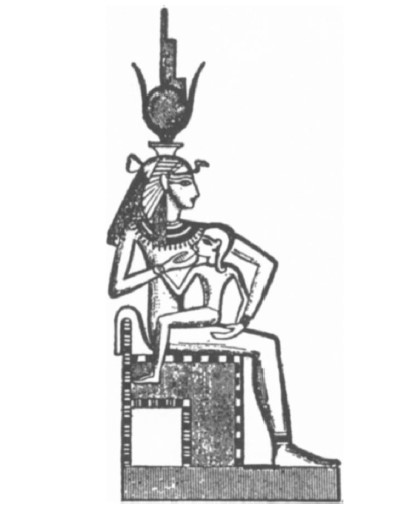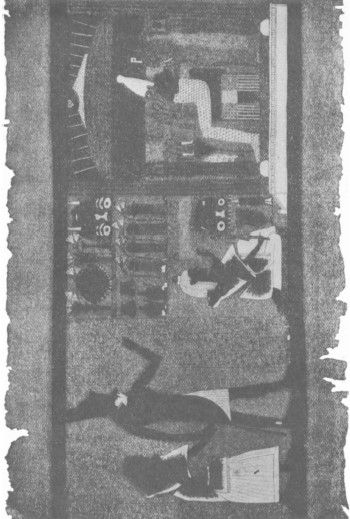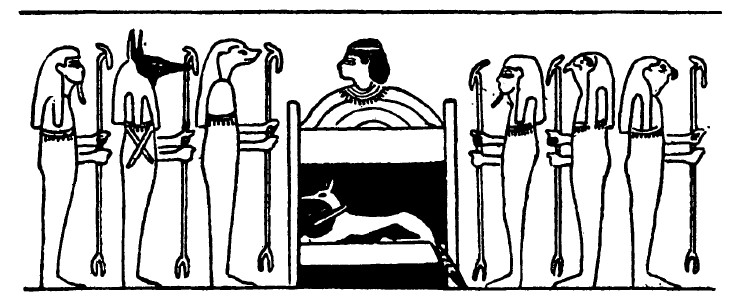The Jews, who were totally unable to express them selves in pictorial and plastic art, which was forbidden them by their religion, poured all their genius into their sacred writings. The very opposite of the Jew, the an cient Egyptian was particularly skilful in sculpture and wall-decoration. But the peculiar formation and position not without its animal symbolism, of which the most prom inent examples are the Lamb of God and the Dove of the Holy Spirit.

ISIS NURSING HORUS.
?But besides animals, M. Lef?bure has shown that the Egyptians dei fied all the aspects of nature ; the atmosphere, water, dew, earth, wind, the Nile, sky, heat, drought, damp, cloud, tempest, moon, stars, sun. The same kind of treatment occurs in Apocryphal and Gnostic Acts, where the throne and the cross are deified, and the cross speaks. The following imagery used in Revelations can be par alleled in Egyptian mythology:;( I ) Rev. i. 8.
Alpha and Omega. (2) Rev. i. 13, The golden girdle. (3) Rev. i.
14, The wool-white hair. (4) Rev. ii. 11, The second death. (5) Rev. iv.
6, The sea of glass. (6) Rev. iv. 6, The four beasts full of eyes. (7) Rev.
vii. I, The four angels at the four corners. (8) Rev. vii, 17, The tears wiped away. (9) Rev. ix, 10, The locusts with scorpion tails.
(10) Rev. ix. 19, Lion-headed horses with serpent headed tails. (11) Rev.
xix. 12, Many crowns. (12) Rev. xx.
I, 2, 3, Chaining the dragon. (13) Rev. xx. 10, 11, 12, The lake of fire. (14) Rev. xxi, 18, The wall of Jasper.
Rev. i. 8, “I am Alpha and Omega, the beginning and the ending, saith the Lord, which is, and which was, and which is to come”. . .
. See also Is. xliv. 6, “I am the first and I am the last,” and Is. xlviii.
12. This is not unlike the beginning of Chapter XVII of the Book of the Dead, as translated and noticed by Renouf : “I am he who closeth, and he who openeth, and I am but One. ” But the texts which contain this opening phrase do not agree, and this sentence is absent from the primitive recension on the walls of Horhotep’s tomb. The XVIIth Chapter is one of the most remarkable and ancient chapters in the Book of the Dead, where the deceased assimilates himself to the Deity as primordial God and Creator (Pierret). It was so ob scure to the Egyptians themselves, that it is full of their notes and explanations, and questions, such as “What is that ?” mixed up in the text.
The latter part of the much quoted sentence of Rev. i. 8, “Which is, and which was, and which is to come” also seems to have an Egyptian analogue, as the Egyptians divided mankind into the Pait, the past, or dead; the Rechit, or present, living generation; and the Hamemet, the future unborn generation. On an obelisk of the XHth dynasty, at Alnwick Castle, Osiris is called “Lord of Be ing and Not-being,” i. e.
, of everything. (2) The Golden Girdle, and (3) The Wool-white Hair. Rev. i. 13, 14. “One like unto the Son of man, clothed with a garment down to the foot, and gir with a golden girdle.
His head and his hairs were white like wool”. . . .
One of the vignettes in the beautifully illustrated pap yrus of Ani, (c. 1500 B. C. ) in the British Museum, has a representation of Ani, the man for whom the papyrus was made, being led into the presence of the enthroned Osiris by the god Horus, who acts the part of Psycho pompos. Ani wears his hair in jet-

HORUS LEADING AN I BEFORE OSIRIS.
” This is adorned with an uraeus, serpent, the sign of the queen’s rank. Rev. ii. 11.
“He that overcometh shall not be hurt of the second death. ” The “second death” or annihilation is frequently men tioned on Egyptian coffins. On that of the lady Tauhert, a singer of Amen, (translated by Piehl,) is written “O mother Nut (the sky) who spreadeth her wings over me, grant that I may be among the stars Achem-sek, and among the stars Achem-ured; that I may not die the sec ond death. ” On the coffin of Pa-du-pep is written “I make thy way among the stars; thou shalt not die for ever. ” On the coffin of general T’aho, “Thou shalt not die the second death. ” The Egyptians called the blessed dead “the living ones,” as is written on the coffin of Nesi-pa-ur shef,8 where he invokes (as well as the gods) “Ye resting ones who are in Duat, ye who repose, ye mighty souls, ye living ones who are in the grave,.
. . come ye, protect the Osiris, the divine father of Amen Ra, king of the gods, Nesi pa-ur-shef, true of voice (having the creative voice). Grant that he may rest as those who are resting. .
. . May he come and go without repulse at the doors and secret pylons of Duat. May his soul come out and do as he likes. May he refresh himself in the beams of the disk,” etc.
The mit are the dead, those who have died the second death, i. e. , annihilation. (Renouf. ) The second life is the logical consequence of not dying the second death.
This also is frequently referred to. An instance is on the obelisk already mentioned, where Osiris is glorified by the deceased for giving the “delicious breath of life” to the royal son, Beba, in his renewed, or second life. In fact, this expression on certain monuments re places, after the name of the deceased, the more usual maat kheru. In the CXXXVth Chapter of the Book of the Dead, it is written “If this chapter is known to the deceased, he shall not die a second time. ” (5) The Sea of Glass, or Hyaline Sea.
Rev. iv. 6, “And before the throne a sea of glass like unto crystal”; and (Rev. xxii. i) “A pure river of water of life, clear as crystal proceeding out of the throne of God and of the Lamb.
” Dr. Budge has drawn attention to the remarkable fact that the throne of Osiris, in a vignette of the Hunefer papyrus (c. 1370 B. C.
) is represented as placed on water. The Book of the Dead mentions the water beneath the throne of Osiris, in Chapters CXVII and CXXV, (Re nouf s translation and notes. ) Chapter CXVII, “I am he who produceth the water which balanceth his throne, and who maketh his way from the great valley. ” Here the deceased is identified with the Nile and its inundation.
Chapter CXXV, “But who is he whose roof is of fire, and whose walls are living uraei, [this refers to the shrine where Osiris sits on his throne] and the floor of whose house is of running water? Who is it? It is Osiris. ” There seems to be an echo of this sacred water beneath the throne in the third vision of the “Shepherd of Her mas,” where a tower ? the Church ? is built on water. Hermas asks, “Why is the tower built upon the water?” He is told “Because your life is and shall be saved by water” (baptism). Victorinus, Bishop of Petavio (martyred 303, A.
D. ) also allegorized the sea or river proceeding from out of the throne of God as symbolic of the gift of baptism. According to the chronicles of Jerachmeel the throne of glory is so important that it was one of the seven things created before the world. The earth was made from the snow beneath the throne of glory.
9(6) The Four Beasts Full of Eyes. Rev. iv. 6.
“And in the midst of the throne and round about the throne were four beasts full of eyes before and behind. And the first beast was like a lion, and the second beast like a calf, and the third beast had a face as a man, and the fourth beast was like a flying eagle. ” (Compare also Ezekiel’s vision, Ez. i.
4). ?Sir J. G. Wilkinson, as long ago as 1841, suggested a connection between these four beasts and the four funerary genii of the Egyptians, which were also near the throne.
Their names are (1) Amset or Mestha, (2) Hapi, (3) Duamutef, (4) Qebhsen nuf. The first is represented man-headed, the second dog (or ape-) headed, the third jackal-headed, the fourth hawk headed. This order of mention is almost always adhered to. These four genii presided over the intestines and in terior organs of deceased persons, and four goddesses, Isis over Amset, Nephthys over Hapi, Neith over Duamu tef, and Serq over Qebhsennuf acted in consort with them. As Dr. S.
Birch wrote “These genii represented the four cardinal points of the compass, and the deposit of the vis cera symbolized their dispersion to those cardinal points; the viscera, according to Egyptian notions, being the source of all evil to man;” or as Professor Wiedemann expresses it, “The four genii had charge of the viscera of the dead, and were bound to appear at the judgment, be cause it was not the divine ego of a man which sinned, but only his internal organs. ” Therefore the four fune rary genii (also called the children of Horus, the four

VIGNETTE OF DUBLIN PAPYRUS. 39″Nephthys, Osiris, Isis.
” This inde pendent knowledge he ascribes to the Chaldsean astrol ogers. But though it is possible that Ezekiel, whose vision is dated from the river Chebar (593-592 ?. C. ) was in fluenced by the Chaldsean form of the genii, St. John is much nearer the Egyptian form, for he leaves out the wheels, and retains Egyptian traits, such as the four beasts being “round about the throne,” for they are always placed very near the enthroned Osiris, in front of him.
But in one Egyptian point Ezekiel’s description is more exact, namely in the order of mention of the genii. In Ezekiel the faces of the four living reatures are (i) man, (2) lion, (3) ox, (4) eagle. Observe the order; it is pre served in the mention of the four funerary genii or chil dren of Horus: (1) Amset, man headed; (2) Hapi, dog headed; (3) Duamutef, jackal-headed; (4) Qebhsennuf, hawk-headed. That in the course of so many centuries the dog has become a lion, the jackal an ox, and the hawk an eagle in the Hebrew version is not surprising. But it

GENII AROUND A COFFIN. Papyrus in Trinity College, Dublin.
Four of these seven are the four genii, and they are represented in the vignettes of papyri with their names often written over them, standing by the “coffined” deceased. These seven luminous ones are the constellation of the Great Bear, or the “Thigh,” as the Egyptians called it. In the papyrus of Ani, it is called “The seven bright ones who follow their Lord. ” Doubtless the four beasts had an astronomical origin.
The detail “Full of eyes before and behind” represents the starry sky. 11 It has been suggested by Mrs. Nuttall that Osiris was originally the pole-star, and as sidereal worship seems to be more archaic than solar worship, her view seems quite possible. The remote antiquity of the four genii, or children of Horus is fully certified to be 5,000 or more B. C. ; for these genii are frequently mentioned in a fully developed form in the Pyramid Texts, which are considered by M.
Mas pero to be pre-Mena. In the text of Pepy I, of the fourth millennium B. C. we find “O children of Horus, carry your father, this Osiris Pepy (the deceased king) ; guide him, make him survive, make him open his mouth, and hold himself upright. ” This shows that the worship of the four genii, as powerful agencies in favor of man after death, was even fully developed in the fourth millennium B.
C. and formed part of the most ancient mythology of the Egyptian religion. The four genii are adopted into apocalyptic Judaism, as well as into Christianity, as is seen from the Book of Enoch (first and second centuries B. C), xl. 2, 9: “And I looked, and on the four sides of the Lord of Spirits I saw four presences. .
. . I asked the angel of peace. . . .
4Who are these presences ?’. . . . And he said to me, This first is Michael,12 the merciful and long-suffering; and the second who is set over all the diseases and the wounds of the children of men is Rufael; and the third who is set over all the powers is Gabriel; and the fourth who is set over the repentance and hope of those who inherit eternallife, is named Fanuer ” (afterwards Uriel).





